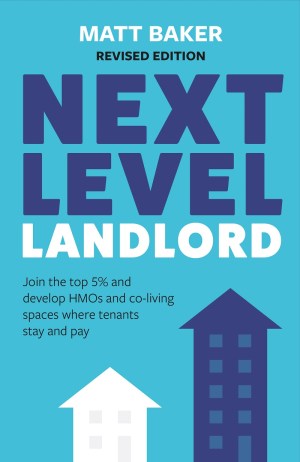The second edition of Next Level Landlord by Matt Baker has been released, which has been updated to reflect the latest housing figures and planning rules. The following is an adapted extract from the second edition of the book.
You may be wondering if the HMO market is for you. Go to networking events across the country and you might hear: ‘The HMO market is dead!’ or ‘The HMO market is saturated!’
Actually, I agree. The part of the market where most HMOs are has become commoditised: it’s all about price now. In fact, it isn’t such a bad thing for potential landlords to believe that the HMO market is difficult to crack, because it’s true – and will start to put off more potential investors. Landlords are being prodded, poked and squeezed from every direction by government, councils, HM Revenue & Customs, banks, competition in the marketplace and tenants, making executing successful HMOs more challenging. But we have proved it can still work well when you focus on implementing the five Tenant First principles of being a Next Level Landlord.

Despite the pandemic that began in 2020, the HMO market is evolving and becoming something new, with opportunities for responsible, quality HMO landlords. I’m going to show you how to level up your property portfolio and capitalise on it. This book shares not just the how’s of being a Next Level HMO® property investor, but also touches on many of the whys and who’s: snippets that highlight what my team and I have gone through to achieve results.
For me it always comes back to building a sense of community, creating something amazing for the benefit of all involved. When this intersects with a great business, the magic happens.
Learn to love your tenants
I’m sure you will have heard of the Pareto Principle: the 80/20 rule where roughly 80% of the effects come from 20% of the causes. For Next Level HMOs, it is no longer 80:20, it’s 95:5. If you focus your attention on creating a co-living portfolio in the top 5% of all the shared properties in your areas, you will have a much easier life. This is the top 5% in design, space and service.
Tenants are the lifeblood of our business, so if we spend the necessary time to get this bit right, we can learn to love our tenants. And we must: they pay for our mortgages, cars and holidays, and help us ensure financial security for the future.
The next time you find yourself moaning or complaining about something a tenant just did, remember the mantra: ‘Love your tenants,’ as they’re providing your income now and in the future.
 Creating attractive properties
Creating attractive properties
Anything commoditised has low profitability.
In the late 1990s, computers had become beige boxes while the profit margins had dropped to single digits, as Compaq, Hewlett Packard and Dell all competed.
Then Steve Jobs shows up in the marketplace with a product that’s anything but: colourful, see-through boxes – completely different, exciting-looking computers. The profit margins on Apple computers jumped to more than 25%, with a strategy all about profitability, not market share. You could buy any number of beige boxes, but there was only one iMac.
What would the property equivalent look like: a colourful, creative, interesting HMO? What’s the one that’s going to make the profit when tenants are out there looking at properties to live in, are excited to move into and for which they’re willing to pay more.
Creating attractive properties
It’s important to follow the 95:5 rule and become the top 5% of shared properties – the only one doing what you do in your area. The top 5% is where customers are willing to pay for quality design, space and service. As Apple dropped the word ‘computer’ from what it sells, drop the ordinary from yours: it’s no longer an HMO, but a ‘shared-living community’ or ‘co-living experience’. No longer a room to let, but a home in which to enjoy months and years of life.
Plenty of people out there will try to convince you that to be a successful landlord, you should create a soulless, empty property devoid of all personality. But the truth of that is ending up with constantly rotating tenants: your life will become increasingly taken up by the mundane problems of running a poorly performing portfolio.
I expect you to question this assumption and logic, to say there’s no money in doing the basic, boring stuff. But read on.
What is an HMO?
This is a national, technical definition in the Housing Act 2004, which is, in summary: ‘An entire house or flat, which is let to three or more tenants who are not from one household, for example, a family, and who share a kitchen, bathroom or toilet’.
An HMO is defined by the Government, so it certainly can be used to describe most types of shared accommodation.
How do you perceive a typical HMO, what does it conjure up in your mind? Do you see it, as some do, as a derogatory word to describe a slum? Do you see the rinse-and-repeat beige box, or an insightful way to provide quality accommodation to those who cannot afford independent housing?
When we saw the term ‘HMO’ being used to describe lots of different types of properties – the good, the bad and the downright ugly – we coined the term ‘Next Level HMO®’, which we registered to distinguish us from the other, arguably lesser standard of HMOs out there.
This distinction is about more than just design; it’s about what makes a property desirable to a tenant while remaining profitable for us. It means taking our whole business concept to a new level.
The Next Level HMO®️
There are six facets to the Next Level HMO®, covering the benefits to both investor and tenant.
The Next Level HMO®…
Offers good return on investment. The Next Level HMO® frees up equity by adding value to the property, while maintaining high cash flow.
Benefits from economies of scale. One way we get a high return and cash flow is to target slightly larger properties where we can design more income-producing rooms in a building. Why? Because running costs don’t increase proportionally with an increase in the number of rooms. For example, to run a six-bed HMO doesn’t cost all that much less than running an eight-bed HMO, and because the eight-bed property generates more income, it leaves more cash in your pocket at the end of each month.
Has achieved planning permission. This happens either as a small HMO in an area with a relevant Article 4 directive, or with seven or more occupants. Why? Because planning permission can dramatically increase the value of a property.
Is a converted building. The Next Level HMO® is often an old, underused commercial building converted into a cluster of flats. For example, by taking an old office block and dividing it up to create seven three-bed flats, it can be designed as shared rental accommodation for twenty-one people.
Is a design-led property. Tenants need to love the place in which they live. There’s no point in creating a product, no matter how wonderful, if there is no target market. Before you begin, the most important task is to research your end user and create a product that meets their needs. For example, while some people might not mind or even enjoy living with seven other individuals, others may vastly prefer to live with just two or three other people.
Is a service-led property. Giving your customer – your tenant – their best experience at whatever stage of life they are, ensures that they stay for a long time and rave about you as a landlord. Wouldn’t it be great if your business could start to sustain itself just from word of mouth?
However you get there, the point is the same: create a product that’s better designed, and a service head and shoulders above its competitors. Your property will be more profitable and much more valuable. It’s highly likely that by focusing on these points, the property has now become a co-living property.
More details on Next Level Landlord.


